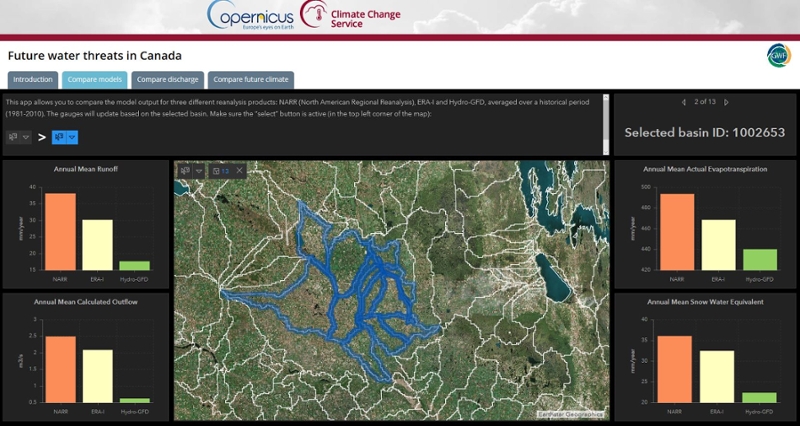
Putting research into active use: HYPE an international example of success
Global Water Futures (GWF) has developed a number of important international linkages, expanding its scientific activities to address water issues globally.
By Hayley Carlson
For example, GWF works closely with the Sustainable Water Futures Programme of Future Earth, collaborating with other research experts to understand more about increasing risks to important mountain water resources and co-hosting an information exchange and capacity building workshop in Bengaluru later this year. Outcomes from the 39 research projects funded under GWF will contribute to the United Nations (UN) Water Action Decade and Sustainable Development Goals through supporting integrated water resources management and strengthening resilience and adaptive capacity to climate-related hazards. GWF is also a Regional Hydroclimate Project of the Global Energy and Water Exchanges projects (GEWEX) of the UN World Climate Research Programme. This partnership will allow greater access to global modelling and satellite data, and in turn, provides a forum for GWF to communicate research results to the international community.
Another important international connection is with the European Union’s Earth Observation Program Copernicus. GWF defines ‘knowledge mobilization’ as the process of moving knowledge from formal research into active use - this is precisely the mission of Copernicus, which acts as a central European data hub to support decision-making around the sustainable management of resources. With the support of partners such as the European Space Agency, Copernicus combines satellite and in-situ (on the ground) data in convenient indicators to help researchers, policy analysts and practitioners understand past and future trends. All information is provided free and open access to anyone who wishes to use it.
Specifically, Copernicus provides information support services focused on six themes – atmosphere, marine, land, security, emergency and climate change. The Copernicus Climate Change Service (C3S) is the most recent of these, coming on line operationally in July 2018. C3S aims to support climate change adaptation and mitigation by providing reliable, open access information about climate change, and works with end-users to refine products to meet the needs of decision-makers and partners. A recent C3S product showcases regional projects to demonstrate best practices around user uptake of high-impact and relevant climate information from the C3S Climate Data Store. The Canadian showcase features Global Water Futures and work by Integrated Modelling Program for Canada (IMPC) researcher Dr. Tricia Stadnyk. Dr. Stadnyk’s work uses the Hydrological Predictions for the Environment (HYPE) model to explore uncertainty in projected streamflow under future climates.
“The Nelson-Churchill basin has a history of large flood events, and climate change introduces additional uncertainty around future net basin water supply,” says Dr. Stadnyk. “I work closely in partnership with Manitoba Hydro which owns and operates hydropower stations within the basin. Small changes in water supply can cost millions of dollars in lost hydropower revenue and large infrastructure requires a 100 to 500 year time horizon for planning and licensing, so it is important to know more about projected streamflow in the long term.”
In addition to projected streamflow and water supply, stakeholders are also interested in the uncertainty associated with the choice of data products used to drive the modelling work. “Another advantage of our work” says Dr. Stadnyk, “is that it can help our partners understand more about how different input datasets can impact model outputs – our results indicate that significant uncertainty is introduced in model simulations depending on the climate data product selected.”
In the C3S showcase, Dr. Stadnyk and her team use output from the fifth generation of the Coupled Model Intercomparison Project (CMIP5) - available from the C3S Climate Data Store - to drive future streamflow projections. Three historic, reanalysis climate datasets (NARR, ERA-I and HydroGDF) are used for bias correction and downscaling for intercomparison. The research team also created two versions of HYPE - one with basin regulation (i.e., hydroelectric structures, reservoirs, irrigation withdrawals, etc.) represented, and another with regulation removed and where land cover was reverted back to its pre-regulation state – to run for past and future time periods using the HydroGDF dataset.
Results indicate that future runoff in the Nelson-Churchill basin could be up to 40 per cent higher in some scenarios relative to the 1981-2010, but this is highly variable across the basin. Conversely, snow water equivalent is projected to decrease across all basins under future climates, indicating a distinct shift in seasonality.
“Overall, our analysis suggests that evapotranspiration in upstream sub-basins is more likely to offset increases in runoff,” remarks Dr. Stadnyk. “While peak discharge will occur earlier in the year in both the upstream and downstream, the latter is more likely to experience both the cumulative impacts of increasing precipitation and increasing variability and magnitude of discharge. This has implications for operating range.”
On the website, these results and others are displayed in a digital storytelling format. An introduction to the project and rationale is provided in a story map format and users can select between tabs to interact with the modeling results and compare future climate trends.
Dr. Stadnyk is a strong supporter of knowledge mobilization and community engagement in research. “Manitoba Hydro utilizes these models and simulations of future hydrologic scenarios as input into their long term hydroelectric generation planning and resource operations modelling,” she says. “It is important for them to know what to expect on long-term horizons because they are building generating stations today (e.g., Keeyask) that will be in service for 100 years or more. Across the Canadian Prairies, climate change translates to more uncertainty in the water supply; and without significant capacity to store water, Manitoba Hydro must ensure they can meet hydropower demand from the water that flows - even under drier conditions.”
You can learn more about this work here.
